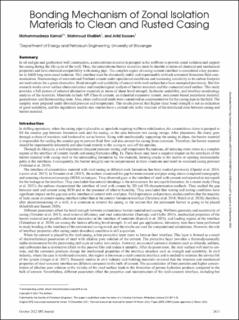| dc.contributor.author | Kamali, Mohammadreza | |
| dc.contributor.author | Khalifeh, Mahmoud | |
| dc.contributor.author | Saasen, Arild | |
| dc.date.accessioned | 2023-03-30T13:55:01Z | |
| dc.date.available | 2023-03-30T13:55:01Z | |
| dc.date.created | 2022-11-23T09:42:56Z | |
| dc.date.issued | 2022 | |
| dc.identifier.citation | Kamali, M., Khalifeh, M., & Saasen, A. (2022). Bonding Mechanism of Zonal Isolation Materials to Clean and Rusted Casing. SPE Journal, 27(05), 2613-2627. | en_US |
| dc.identifier.issn | 1086-055X | |
| dc.identifier.uri | https://hdl.handle.net/11250/3061231 | |
| dc.description.abstract | In oil and gas and geothermal well construction, a cementitious material is pumped in the wellbore to provide zonal isolation and support the casing during the life cycle of the well. Thus, the cementitious barrier materials must be durable in terms of chemical and mechanical properties and have chemical compatibility with casing pipe. The complex region of casing-cement interface is considered a key parameter to fulfill long-term zonal isolation. This interface must be chemically stable and impermeable to block unwanted formation fluid communication. Shortcomings of conventional Portland cement under operational conditions and increasing sensitivity to its carbon footprint are motivations for a green alternative. Bond strength and sealability of cement with steel surface have been measured previously. But few research works cover surface characterization and morphological analysis of barrier materials and the connected steel surface. This study provides a full picture of selected alternative materials in terms of shear bond strength, hydraulic sealability, and interface morphology analysis of the materials. Materials include API Class G cement, an industrial expansive cement, noncement-based pozzolanic material, geopolymer, and thermosetting resin. Also, clean and rusted steels were considered as a representative for the casing pipe in the field. The samples were prepared under elevated pressure and temperature. The results proved that higher shear bond strength is not an indication of good sealability, and the ingredients used to mix slurries have a critical role in the structure of the interfacial zone between casing and barrier material. | en_US |
| dc.language.iso | eng | en_US |
| dc.publisher | Society of Petroleum Engineers | en_US |
| dc.rights | Navngivelse 4.0 Internasjonal | * |
| dc.rights.uri | http://creativecommons.org/licenses/by/4.0/deed.no | * |
| dc.title | Bonding Mechanism of Zonal Isolation Materials to Clean and Rusted Casing | en_US |
| dc.type | Peer reviewed | en_US |
| dc.type | Journal article | en_US |
| dc.description.version | publishedVersion | en_US |
| dc.rights.holder | The authors | en_US |
| dc.subject.nsi | VDP::Teknologi: 500 | en_US |
| dc.source.pagenumber | 2613-2627 | en_US |
| dc.source.volume | 27 | en_US |
| dc.source.journal | SPE Journal | en_US |
| dc.source.issue | 5 | en_US |
| dc.identifier.doi | 10.2118/209812-PA | |
| dc.identifier.cristin | 2078882 | |
| cristin.ispublished | true | |
| cristin.fulltext | original | |
| cristin.qualitycode | 2 | |

